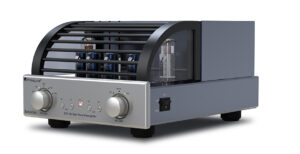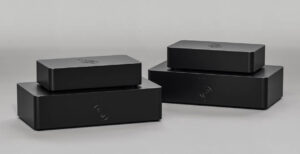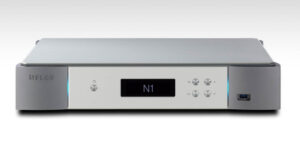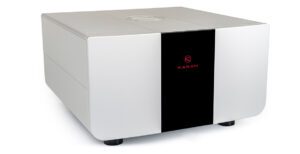
A couple of years ago, the concept of an audiophile network audio switch was all but the stuff of sci-fi. Now, however, it has become a staple of the modern face of good audio. What’s changed? In no small part, it’s the result of an ever-broader acceptance and understanding of audio meeting the requirements of networked audio. The ‘everything makes a difference’ drive of modern audiophiles might not extend to the direction of a water faucet or folding over pages in books anymore (what happened in the 1980s stays in the 1980s), but it does reach almost everything electronic in and around the audio system. The RANS-1 by Russ Andrews takes a lot of the good concepts in traditional audio electronics and applies them to the network connections we use to get the music that drives those audio electronics today.
The RANS-1 approaches the network switch in a classic audiophile way; it separates the boxes into ‘gubbins’ and ‘power supply’, then uses higher-grade components in both to get the best possible performance out of the ‘gubbins’ part. l am not being dismissive here; this is a tried, tested and trusted way of improving an electronic circuit in the audio world and it has worked for the preamp, phono stage, DAC and even streamer, so why shouldn’t it work on a network switch? OK, the naysayers (of which there are many, and Russ Andrews makes products that are naysayer-magnets at times) will argue that in many cases adding a separate power supply and more esoteric components in a device is little more than gilding the lily, but they say that about a lot of things. Sometimes, a spot of lily-gilding can produce results, even ones that aren’t in the 1940s book of audio engineering.

The Russ Andrews RANS-1 is an eight-port gigabit switch in identical and nondescript enclosures with pinpoint blue LEDs on the front and the usual array of yellow and green LEDs to accompany each port. This eight-port switch is given additional shielding and damping, as well as a custom Trichord clock. The box without any ports is a linear power supply with a single IEC inlet (a Russ Andrews Yello power cord is provided) and the two are connected by locking three-pin power connectors, with a short (0.3m) Kimber PBJ cable to hook them together. The power supply feeds the switch and its internal clock with separate supplies. I guess if you asked nicely you could play ‘Pimp My RANS-1’ with a more exotic power cord and connecting cable, but this is more than enough.
My sample came pre-used through the review circuit (we’re not the first to review the RANS-1, and the box it came in free from instructions and was more ad hoc than we’ve come to expect from Russ Andrews), so there was no need for running in and the box was good from the get-go. I used it to connect the Linn Klimax DSM tested in this issue, both to the outside world and to a range of servers (Naim and Melco) during the test. I also compared it with the Melco S100 switch and a baseline Netgear eight-porter. Finally, I compared it to the Network Acoustics ENO filter and used that in and out of the digital chain.
The RANS-1 fared extremely well in all settings, demonstrating a quieter, more controlled sound throughout. Naturally, its biggest differences were heard comparing this to the Netgear baseline switch. This budget device seemed to give the sound a nasality and unsatisfying forward-brightness to the sound that might seem initially ‘clean’ but was ultimately ‘grating’. This applied whether streaming locally or online. Swapping that Netgear box out for the Russ Andrews
RANS-1 switch (with no other changes) was a subtle shift in the right direction, making music more approachable and listenable. It replaced that fake ‘clean’ sound with a sense of balance and musical order.
The results were less clear cut between the Melco and the RANS-1, with the Melco going more for the sheer detail of performance and the Russ Andrews going for a more sonorous and relaxed approach. Both were extremely musical sounding, just musical in different directions. Finally, in the ‘compare and contrast’ part, the ENO filter levelled the playing field somewhat, making all three options less marked in performance boosts. Nevertheless, the combination of ENO+RANS-1 works extremely well… and sounds like a German experimental album title from the 1970s.

Taken on its own, the Russ Andrews RANS-1 really does demonstrate just why the audiophile network switch is a viable product in today’s audio. It’s a subtle performer, gently and quietly improving the lot of streamed audio by making it sound more ‘human’. Backgrounds are distinctly quieter, the treble is more refined and less harsh and forced sounding. There’s a sweetness and ease to the sound, but it’s one with a gently-focused sense of rhythm too. In a medium that is often accused of being loud and shouty at times, the RANS-1 shows it’s possible to be deft and delicate, without being ‘flaky’ sounding.
In truth, I’ve been sort of avoiding the whole audiophile switch due to my own digital preconceptions. Packetised data should be unfazed by its transfer through a network, but the RANS-1 makes a convincing argument that there’s more to the topic than it first appears. This is a true eye-opener.
TECHNICAL SPECIFICATIONS
- Type: Network Switch with external power supply
- Ports: 8 RJ45 gigabit ethernet ports with additional shielding and damping
- Clock: internal re-clocking with custom made Trichord unit
- Internal wiring: Kimber Kable
Russ Andrews 0.3m DC link cable made with Kimber PBJ and locking connectors
4mm grounding socket - Casing: Custom, matching ABS cases
- Dimensions (W×H×D): 187 × 47 × 130mm per unit
- Price: £956.50
Manufacturer: Russ Andrews
URL: russandrews.com
Tel: +44(0)1539 797300
Back to reviews https://hifiplus.com/reviews
By Alan Sircom
More articles from this authorRead Next From Review
See all
PrimaLuna EVO 100 phono preamplifier
- Apr 22, 2024

Reiki Audio SuperSwitch Master Pro + Servant Pro
- Mar 27, 2024

Melco Audio N1-S38 music server
- Mar 27, 2024











